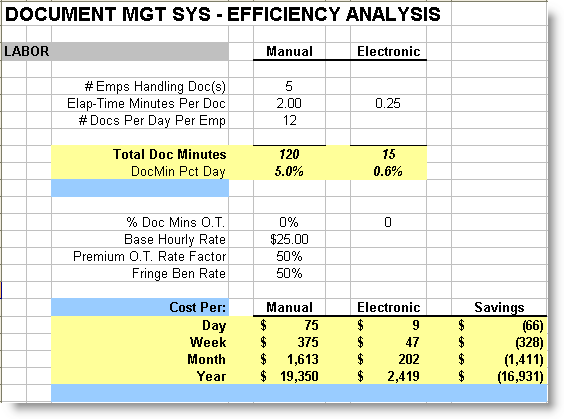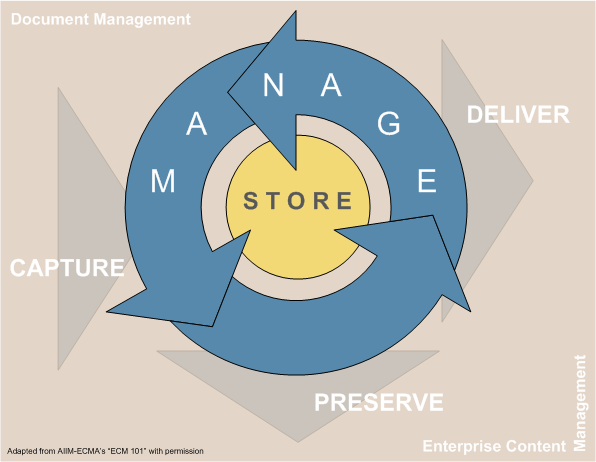
FEATURE ARTICLE
Document Management Systems:
Developing an Approach
With the release of UnForm 7.0 in August 2006, SDSI has positioned itself as a
provider in
the document management
solution marketplace.
If document management is now on your radar screen, as it
very much appears to be for many new, existing, and prospective end-users
and resellers of UnForm, then likely you need answers to the following questions:
-
what constitutes a document management solution (DMS), and what
does it do;
-
what is the major significance of "documents" in an organization;
-
how do you or your clients go about justifying the investment in a
DMS, and
-
what are the benefits of implementing a DMS with UnForm
versus some other solution.
This article should start you on the way to considering and finding
answers to these important questions.
The answers to these questions can signify
opportunities for the organizations that want to employ a DMS in their
organization, as well as for the individuals and companies who recommend,
provide and implement the adopted solutions.
What is a document management system?
A computer system or set of computer programs used to
store and track
electronic documents and/or images of paper documents.
Let's keep it that simple, for now. We'll elaborate further below.
The
Central Role of Documents in Businesses and Organizations
Besides technological advancements that have radically
driven down the cost of electronic storage, there are two very good
reasons that the DMS marketplace is receiving a lot of attention.
According to Kevin Craine, author of
"Designing a Document Strategy"
(footnote 1):
-
Documents play a central role in the activities of organizations.
-
The roles of documents in an organization are both strategic and
tactical,
and cannot be ignored for long without crippling some aspect
of the organization’s overall mission or objective.
Another way of looking at it is, simply:
Documents are the life-blood of
an organization.
Making improvements in the management of documents can have
a significant impact on efficiency, employee morale, and the bottom line.
Justifying the Investment: Improved Efficiency
Most organizations are looking for a document management
system because of the potential for improved efficiency.
A recent survey on the
state of the ECM industry (enterprise content
management) published by AIIM-ECMA
(footnote 2), discovered that, among the “most significant business
drivers” behind organizations' current interest in ECM technology
as cited by respondents,
improving efficiency was number one, out of a total of eight
other business drivers listed.
As a group, organizations classified by their survey responses
as “Cost-Driven Users”, because they chose as a main business driver either
- improved efficiency,
- reduced costs, or
- increased profits/improved performance,
outnumbered those classified as "Customer-Driven Users" and
"Compliance-Driven Users".
Compliance-oriented issues probably occur more
frequently in much larger organizations, while efficiency-oriented and
customer-oriented issues are shared by all sizes of organizations.
But the reason for citing these survey results
here is to emphasize the fact that EFFICIENCY is usually the PRIME
motivator and common denominator shared by organizations that are
seriously contemplating ECM or DMS solutions, and as such, should be the
primary focus of a strategy to approach either the marketing or the
implementation of a DMS.
In our 3Q 2006 NewsPages article on UnForm 7
Document Management we identified a number of reasons why organizations
electronically archive documents. We prefaced the list with the
observation:
“ … they all
boil down to EFFICIENCY ”
To recap, the main reasons given and elaborated upon
in the article were:
- Lower paper usage, eliminate physical handling
steps
- Enhanced security over document resources
- Streamlined organization, minimization of clutter
- Lower storage costs compared with bulky filing
and storage systems
- Relegate paper to a backup position
- Work-flow improvement with document matching
- Ease, speed, and flexibility of document access
- Reduced overhead
- Address environmental concerns
The hidden costs of document handling are an area where
an organization can often quickly identify whether there are efficiencies
to be gained from electronic document archiving and management.
But how do you measure the efficiency of document processes?
It starts with analyzing, documenting, and
understanding the details of the organization’s work-flow, and how it
relates to processes which use and/or depend upon key “trade”
documents.
Our 3Q 2006 article also defined the characteristics
of trade versus non-trade documents,
with an emphasis on the fact that UnForm processes trade documents for
laser printing and e-delivery purposes, and so is in a prime position to
extend its functionality into the archiving and management of those same
documents.
A document-based work-flow analysis is in many ways an
inherently “accounting-centric” process, to the extent
that a majority of an organization’s key legal and trade documents are
accounting-related, and often produced and processed by an accounting
software system, or accounting-intensive ERP solution.
The size, complexity, and even the culture of the
organization will determine the type, nature and extent of a work-flow
analysis, but it is always a process that is designed to
determine efficiency, and improve efficiency where possible.
I.T. personnel, especially managers,
often need to understand how to measure efficiency and be in a position
to advise line managers and executives on the efficiency gains which can
be expected from implementing I.T. solutions.
Independent consultants, integrators, and
resellers also need to be in a position to assist clients and
prospects determine their needs, and this often involves helping to
measure expected efficiency gains from a technological solution.
Those inside an organization who are tasked with improving efficiency
or providing analysis support for that process often have a good
grasp of the mathematical and financial approaches to quantifying efficiency
improvements.
But let's review here some of the basic concepts of efficiency analysis.
The Efficiency Equation
Efficiency is the ratio of output to input:
- Holding input constant and
increasing output increases
the efficiency ratio.
- Holding output constant and
reducing input also increases
the efficiency ratio.
- A combination of lower input and greater output increases
the efficiency ratio more than when holding either factor constant.
Relative labor cost is often the most obvious measure of efficiency in an
organization when it comes to analyzing business or department performance.
In this scenario, labor cost is usually an input factor, and the
output
is a certain level production, like customer orders serviced.
Since labor cost is an input factor, we are looking for a reduction in
it to increase efficiency. So we might assume that orders serviced will
stay constant. Alternatively, if we want to keep our same level of
staffing, keeping labor cost constant as an input, then we would need to
measure efficiency by any change in volume of orders able to be serviced, the output factor.
In the sample below, we make a quick measure of a process efficiency by
looking for a reduction in the labor cost while holding orders serviced
constant.
Sample Efficiency Analysis - Part 1, the Savings
5 people spending 5 percent of their workday handling questions and problems
which require retrieving a document from a physical, centrally located file
cabinet. In this case the "5 percent of the workday" comes from 12 documents
per day per employee taking an average of 2 minutes to retrieve.
IF electronic retrieval of the same document can be achieved on the desktop
in an elapsed time of 15 seconds, instead of 2 minutes, and the administrative
employees involved earn $25 per hour, and do NOT work overtime, the electronic
solution can save almost $17,000 per year.

The daily labor savings using an electronic
solution, with an efficiency factor of 60/$9=6.67,
far exceeds the efficiency factor of 60/$75=0.80 for
manual retrieval. The sixty in the numerator is the number of order
documents, five employees times 12 per day.
Notice that this is a numerical factor or ratio, and is NOT expressed as
a dollar cost per document.
Inverting the equation would express the efficiency
ratio in terms of cost per document, which would be
$9/60=$0.15
for the electronic solution, and $75/60=$1.25 for the
manual solution. When inverting the efficiency equation and expressing
it in terms of "cost per", the lower value obviously expresses the more
efficient solution.
Sample Efficiency Analysis - Part 2, the Comparison of Two Electronic
Solutions
Here we use the cost savings of an electronic solution over a
manual solution from part 1 as our output, and then
compare it with the input, which is the investment
needed to produce the
savings.
If the electronic solution costs $100,000 then the annual
investment efficiency is $17K/$100K=0.17,
versus an annual investment efficiency of $17K/$30K=0.57
for an electronic solution which costs $30,000. The higher
efficiency ratio indicates the more efficient solution.
Investment efficiency is usually expressed taking into account other
additional financial factors like corporate income taxes, the time value
of money, interest rates, years of service, etc., so that it can be
expressed as an ROI, DCF (discounted cash flow), or a
payback period.
But the base ratio mathematics of investment efficiency as illustrated
is a quick, useful benchmark when two or more solutions need to be
compared.
The inversion of the annual investment
efficiency ratio above is a simple payback period:
$100K/$17K=5.88 years for the higher
cost solution, versus $30K/17K=1.76 years (21 months)
for the lower cost solution.
Six years is considered a little long for a payback period on an I.T.
project, whereas 21 months is well under the 3 years that many
accountants use as a payback benchmark.
ECM concepts help further define what
constitutes a DMS
The AIIM-ECMA has put forth a model for depicting
ECM and its
activities and technologies which it makes available to members. It
uses the following high-level outline of functional areas to organize
the activities, methods, technologies, and tools which together comprise
the model. The AIIM-ECMA "ECM 101" model, depicted in
the simplest of formats, stripped of a great many technology options and
considerations, can be boiled down to this:

So let's call this what a DMS does:
A software system that captures, stores, delivers, manages, and
preserves electronic documents.
Note that ECM is considered to be a much broader content "umbrella" that
classifies document management as a subsidiary
component technology. But it seems pretty clear that this same
functional outline can be used to describe document management in a
narrower sense, as well.
DM versus ECM We have positioned Document Management as distinct from Enterprise
Content Management, but also acknowledged that DM is claimed to be a
subset of ECM in
a modern conceptual view of the technology marketplace. When considering DM
solutions an organization may run into proposals for full ECM
solutions, or at the very least, be faced with the need for knowing the
distinctions between the two, and filtering out technology
which could be "over-kill" in addressing
the particular, specific needs an organization has identified.
Strategy Partners International
Ltd, an ECM consultancy firm cautioned against such over-kill in a
2005 whitepaper:
"Bottom Line: Users should focus on
Applications, NOT Infrastructure.
The change that has been taking place
in the past two years is that users can buy the CM solution that meets their business goal, rather than acquiring an expensive CM
infrastructure and then hoping that they can use it to build a series of
applications." (footnote 3) This especially
dovetails with the concept of focusing on the efficiency equation:
remember the impact of a lower cost as an input factor in the efficiency
equation. If an organization has identified specific efficiencies to be
gained from an electronic solution, they may be far better off
purchasing a system which addresses the specific identified efficencies
at a lower cost than spending a lot more money on an entire
"infrastructure" solution with features that may or may not fit the
organization, or may or may not continue to add efficiencies down the
line.
Accounting-centric Document Management
A useful
distinction has arisen in the marketplace by referring to certain
solutions as being "accounting-centric".
This seems
like the most useful distinction to make regarding the marketplace that
SDSI and its channel partners operate in with UnForm software. By and large we are dealing
mostly with transactional content and its related
documents in support of accounting activities, and in support of access
to trade-oriented, or transaction-oriented documents on the part of
internal and sometimes external entities.
SDSI's Implementation of Document Management:
An Accounting-centric Implementation The logic of SDSI’s move into the document management
arena is clear when you consider SDSI’s underlying assumption about document
archiving, especially as it relates to existing users of UnForm in
its capacity as a Laser forms and E-document delivery tool:
-
UnForm has intimate knowledge of an organization’s
mission-critical trade document data stream through its base print-stream
filter technology.
-
If archiving and document management solutions can be said to "live and breathe" by the efficiency
of their retrieval indexing and other meta-data property creation systems,
then a tool already acting as a print-stream filter is in a unique and
primary position to be tasked with the function of archiving the output,
since it already has access to most or all of the information
that is critical for proper indexing and meta-tagging.
A whitepaper is available from our
website,
www.synergetic-data.com/UF7_whitepaper.pdf
, which further discusses the full breadth of UnForm's document
management features and capabilities.
Conclusion
Recommending or implementing a document management
solution requires some level of understanding of the overall marketplace
for related technology. But more than that it requires an understanding
of the efficiencies to be gained from electronic archiving, retrieval,
and management. Every organization has a different and unique set of efficiency
equations which need to be compared with those which will result from
the use of an electronic solution.
UnForm 7.0, because of it's inherent
design as a filter for capturing, enhancing and delivering accounting
system content as a forms and report processing tool, is unique
in the document management solution marketplace.
Those who implement UnForm with a strategy of maximizing efficiency
based on a clear
understanding of the work-flow and document handling issues which are
unique to their own environment, are choosing a solution with a long
history of automating accounting-oriented forms and processes.
UnForm has and will continue to evolve its
document management capabilities along with the needs
of our users, and with feedback from our channel partners.
Document-centric management solutions are clearly
where client-server component software technology can contribute
significantly to improving organizational efficiency.
With the central role that documents play in any
organization, efficiency improvements that target key documents are sure
to pay ongoing dividends.
Footnotes:
1 Kevin Craine, Designing a Document Strategy
(MC2 Books, 2000).
2 AIIM - The Enterprise Content Management
Association,
www.aiim.org,
State of the ECM Industry, Moving from Why? to How?: The
Maturing of ECM Users, AIIM Industry Watch Survey, 2006
3 Strategy Partners International Limited (Rory
Staunton), European Content Management Update, 2005. p.14.
www.startegy-partners.com

|

